- 27 JUILLET
- INDI-UNI : 
PRE-INSCRIPTION : 15 Juin – 15 Août
PRE-REGISTRATION: June 15th - August 15th
- FIDJI – 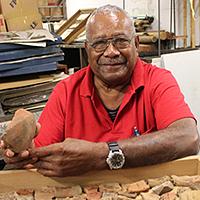 Vorovoro - For the first time ever, Lapita pottery has been discovered on Vanua Levu. The pottery dating back 1100BC has been found on Vorovoro Island near Labasa. Fiji Museum Chief Archeologist, Sepeti Matararaba said they thought Bourewa in Nadroga was the first settlement in Fiji however with this new find at Vorovoro, it meant that the first people to come to Fiji not only settled in Baurewa but split up and also settled in Vorovoro.
Vorovoro - For the first time ever, Lapita pottery has been discovered on Vanua Levu. The pottery dating back 1100BC has been found on Vorovoro Island near Labasa. Fiji Museum Chief Archeologist, Sepeti Matararaba said they thought Bourewa in Nadroga was the first settlement in Fiji however with this new find at Vorovoro, it meant that the first people to come to Fiji not only settled in Baurewa but split up and also settled in Vorovoro.
http://www.fijivillage.com/?mod=story&id=2607110652478f612924c275aef71d
- RUSSIE – Transbaikalia - Russian archeologists from the Far East worked eastwards from lake Baikal and unearthed human remains, which are believed to belong to khan Esunke, Genghis Khan’s nephew.The team of archeologists comes from Far East Federal University and from Far Eastern branch of Russian academy of sciences. The remains were found in an estate, located near a khan’s residence. New findings confirm a hypothesis that after Mongols conquered Primorsky territory and Northeast China, indigenous population left these territories in 10-13 centuries AD. Scientists plan to conduct genetic tests of their findings in Russian and foreign laboratories.
http://www.russia-ic.com/news/show/12548/
- ITALIE – 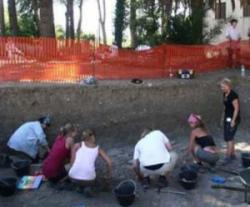 Mount Cimino - Italian archaeologists say they've discovered a sacred site where Etruscans worshiped gods and burned sacred objects in their honor 3,000 years ago. The site was found at Mount Cimino near Viterbo, 50 miles north of Rome. Archaeologists led by Professor Andrea Cardarelli of La Sapienza University in Rome have carried out excavations on the 3,200-foot summit for the past three years. A number of materials were linked to cult fires and "clear evidence of votive offerings," Cardarelli said. "Religious activities 1,000 years B.C. were carried out through fire," he said. "Offerings were burnt for the gods -- sacred objects, food or animals." The discovery is said to be one of the most important in the early history of Lazio, the region surrounding Rome, with archaeological remnants dating back to 1000 B.C. and the Bronze Age.
Mount Cimino - Italian archaeologists say they've discovered a sacred site where Etruscans worshiped gods and burned sacred objects in their honor 3,000 years ago. The site was found at Mount Cimino near Viterbo, 50 miles north of Rome. Archaeologists led by Professor Andrea Cardarelli of La Sapienza University in Rome have carried out excavations on the 3,200-foot summit for the past three years. A number of materials were linked to cult fires and "clear evidence of votive offerings," Cardarelli said. "Religious activities 1,000 years B.C. were carried out through fire," he said. "Offerings were burnt for the gods -- sacred objects, food or animals." The discovery is said to be one of the most important in the early history of Lazio, the region surrounding Rome, with archaeological remnants dating back to 1000 B.C. and the Bronze Age.
http://www.upi.com/Science_News/2011/07/26/Bronze-Age-holy-site-studied-in-Italy/UPI-25271311697633/#ixzz1TKDGJ76g
- FRANCE – 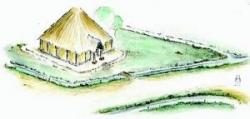 Bergues - La société Archéopole procède à des fouilles sur 26 hectares dans la zone industrielle de Bergues. Le site n'aura pas vocation à être visité mais révèle quelques trouvailles. Entamées depuis le 6 juin, les fouilles ont progressé sur 3,3 hectares des 12 sur lesquelles la société de Linselles interviendra. Au total, 26 hectares sont concernés. Il ne sera pas envisageable de faire un site de fouilles à visiter de ce terrain. Par contre, si nous souhaitons réaliser une exposition avec les objets mis à jour, c'est possible. » Un élément confirmé par Raphaël Pouriel, responsable scientifique d'Archéopole. « Certes, ce que nous découvrons ici est nouveau, nous ne savions pas vraiment ce que nous trouverions. Ce site sera sûrement l'un des plus importants de la région, mais nous n'allons effectivement pas le faire visiter. Nous allons récupérer tous les éléments pour les étudier, les analyser et les archiver. Mais ici, les aménageurs pourront construire. » Cette phase archéologique a donc le mérite de mettre au jour de nouvelles trouvailles telles que des céramiques (datées entre 400 et 250 avant Jésus-Christ), « principalement culinaires », poursuit le responsable scientifique, mais aussi les traces de bâtiments assez imposants. « Nous ne savons pas encore s'il s'agit d'habitat ou de lieux de culte. Mais nous savons qu'il s'agit de vestiges gaulois principalement. Il y a aussi du gallo-romain (IIe siècle après Jésus-Christ) et un peu de carolingien. » A ce jour, 29 enclos (ensemble entourant un bâtiment) ont été découverts. Les fouilles se poursuivent jusqu'au mois de décembre.
Bergues - La société Archéopole procède à des fouilles sur 26 hectares dans la zone industrielle de Bergues. Le site n'aura pas vocation à être visité mais révèle quelques trouvailles. Entamées depuis le 6 juin, les fouilles ont progressé sur 3,3 hectares des 12 sur lesquelles la société de Linselles interviendra. Au total, 26 hectares sont concernés. Il ne sera pas envisageable de faire un site de fouilles à visiter de ce terrain. Par contre, si nous souhaitons réaliser une exposition avec les objets mis à jour, c'est possible. » Un élément confirmé par Raphaël Pouriel, responsable scientifique d'Archéopole. « Certes, ce que nous découvrons ici est nouveau, nous ne savions pas vraiment ce que nous trouverions. Ce site sera sûrement l'un des plus importants de la région, mais nous n'allons effectivement pas le faire visiter. Nous allons récupérer tous les éléments pour les étudier, les analyser et les archiver. Mais ici, les aménageurs pourront construire. » Cette phase archéologique a donc le mérite de mettre au jour de nouvelles trouvailles telles que des céramiques (datées entre 400 et 250 avant Jésus-Christ), « principalement culinaires », poursuit le responsable scientifique, mais aussi les traces de bâtiments assez imposants. « Nous ne savons pas encore s'il s'agit d'habitat ou de lieux de culte. Mais nous savons qu'il s'agit de vestiges gaulois principalement. Il y a aussi du gallo-romain (IIe siècle après Jésus-Christ) et un peu de carolingien. » A ce jour, 29 enclos (ensemble entourant un bâtiment) ont été découverts. Les fouilles se poursuivent jusqu'au mois de décembre.
http://www.lejournaldesflandres.fr/actualite/La_Flandre_interieure/Bergues/2011/07/27/un-des-sites-les-plus-riches-de-la-regi.shtml
- INDE – 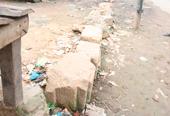 Dhirenpara - Two months ago, a resident of Fatasil Ambari had “discovered” a piece of relic — believed to be part of an ancient stone temple — after which 40 such pieces were found in the area by the state directorate of archaeology. On May 24, 13 of the 41 pieces recovered from Dhirenpara in Fatasil Ambari, were handed over to the directorate. However, 28 of them are still lying where they were found, next to a drain in the area. According to the director of the archaeology department, H.N. Dutta, three big pieces of the 28 were identified, which could not be lifted manually. These relics were initially found at Tokobari while renovating Kelvin cinema. They were moved from there to Dhirenpara where the dug up earth was brought for earth filling.
Dhirenpara - Two months ago, a resident of Fatasil Ambari had “discovered” a piece of relic — believed to be part of an ancient stone temple — after which 40 such pieces were found in the area by the state directorate of archaeology. On May 24, 13 of the 41 pieces recovered from Dhirenpara in Fatasil Ambari, were handed over to the directorate. However, 28 of them are still lying where they were found, next to a drain in the area. According to the director of the archaeology department, H.N. Dutta, three big pieces of the 28 were identified, which could not be lifted manually. These relics were initially found at Tokobari while renovating Kelvin cinema. They were moved from there to Dhirenpara where the dug up earth was brought for earth filling.
http://www.telegraphindia.com/1110727/jsp/northeast/story_14294451.jsp
- TURQUIE – Xanthos - Turkish archaeologists will now be responsible for a dig at the ancient city of Xanthos in the Mediterranean province of Antalya due to the slow pace of excavations under French teams that have been working at the site for 60 years. Bordeaux University has passed on the excavations to a team under the guidance of Professor Burhan Varkıvanç, head of the Archaeology Department at Akdeniz University in Antalya. Turkish scientists have already begun excavations at Xanthos, which had historical significance as the Lycian capital in the 2nd century BC. Akdeniz University’s 23-member team will conduct excavations at the site for two months, said Varkıvanç, adding that the untouched mosaics of the ancient city would be repaired and that the site would soon be cleared. British archaeologists initiated the first excavations in the ancient city between 1838 and 1842. Many sculptures, reliefs and architectural pieces, such as the Monument of Harpy, the Tomb of Payava, and the Nereid Monument were loaded onto ships and taken to England. The excavations in the republican period were conducted by the French universities of Paris and Sorbonne in 1950. After an interval, the excavations were resumed by a Bordeaux University team under Jacques de Caurtils’ direction in 1990. Xanthos was the name of the Lycian civilization’s capital city and the river on which the city was situated. Throughout history, Xanthos was a valuable city for other civilizations to conquer as it was the Lycian center of culture and commerce; the Persians, Macedonians, Greeks and Romans all invaded the city and occupied adjacent territory. Today, the site of Xanthos overlooks the village of Kınık. Once over 500 meters long, the Roman Kemer Bridge crossed the upper reaches of the river near the present-day village of Kemer. The site has been listed as a UNESCO World Heritage Site since 1988, and a Roman theater and the findings on the west side of the theater still attract visitors. Only the duplication of a few of Xanthos’ monuments with hieroglyphics and other works of art can be seen in the region; the original sculptures, monuments, works and other remnants are exhibited at the British Museum. Xanthos was mentioned by numerous ancient Greek and Roman writers. Strabo notes Xanthos as the largest city in Lycia. Both Herodotus and Appian describe the conquest of the city by Harpagus on behalf of the Persian Empire, in approximately 540 BC. According to Heredotus, the Persians met and defeated a small Lycian army in the flatlands to the north of Xanthos. After the encounter, the Lycians retreated into the city, which was besieged by Hapargus. The Lycians destroyed their own Xanthos acropolis, killed their wives, children, and slaves, and then proceeded on a suicidal attack against the superior Persian troops. Thus, the entire population of Xanthos perished, except for 80 families who were absent during the siege.
http://www.hurriyetdailynews.com/n.php?n=xanthos-excavations-turned-over-to-turkish-archaeologists-2011-07-26
- ROYAUME UNI – Sheffield - Archaeologists working at a Sheffield farm have dug up a mystery – the remains of a settlement which could date back 8,000 years to the Iron Age. The dig, aided by volunteers at Whirlow Hall Farm, has found a rectangular-shaped enclosure formed by a ditch. This discovery pushes back farming at Whirlow by at least 2,000 years and will provide new information on the early history of Sheffield. The discovery could be hugely significant for Sheffield, as no farming settlements of this date have yet been found within the city. They have so far been carrying out field walks, geophysical examinations of the terrain and a photographic survey of the historic farm buildings at Whirlow including the medieval cruck barn. The field walking resulted in the collection of over 1,000 finds, including flint tools from the Mesolithic and Early Bronze Age.
http://www.thestar.co.uk/community/greenscene/time_team_dig_up_the_dirt_experts_push_back_origins_of_farming_in_city_s_history_1_3618427
- ROYAUME UNI – Hereford - Moves to uncover the origins of an ancient Golden Valley priory have resumed as part two of an archaeology project got underway. The Ewyas Harold Archaeology and History Group started work last weekend after a gravel bank and 15th century pavement were uncovered last year. Members believe a priory was established in 1130 in a field just north of Ewyas Harold when it was moved from nearby Dulas Court. But research indicates the now redundant St Michael’s Church in the village could also be the original site. In addition, thoughts the building was abandoned in 1358 have also been contradicted by archaeological evidence which suggests occupation in the Ewyas priory field continued for another century.
http://www.herefordtimes.com/news/local/county/9151691.Digging_up_evidence_of_12th_century_life_in_Ewyas_Harold_and_Dulas_Court/?ref=mmsp
- ROYAUME UNI – 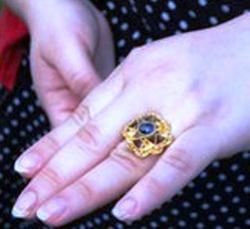 York - A rare sapphire ring, discovered by a metal detector enthusiast, has been bought by the Yorkshire Museum. The ring, found near York and measuring 2.5cm across, could have been made as early as the 7th Century.
York - A rare sapphire ring, discovered by a metal detector enthusiast, has been bought by the Yorkshire Museum. The ring, found near York and measuring 2.5cm across, could have been made as early as the 7th Century.
http://www.bbc.co.uk/news/uk-england-york-north-yorkshire-14308048